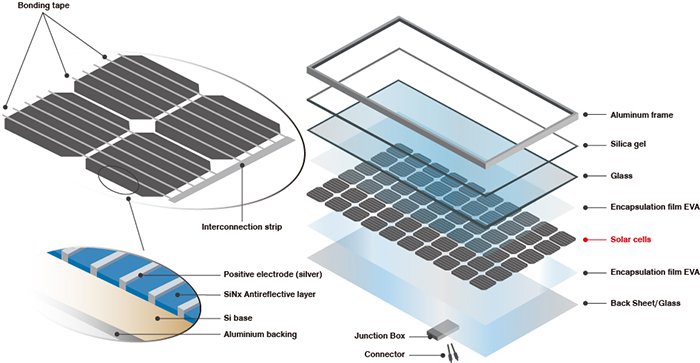Against the backdrop of increasing global attention to environmental protection and sustainable development, photovoltaic (PV) technology, as an important component of green energy, is ushering in unprecedented development opportunities. Looking into the future, PV technology will show remarkable development trends in many aspects, injecting a strong impetus for the transformation and upgrading of the energy field.
First, innovation and development of photovoltaic materials
1. Emergence of new materials: With the rapid development of materials science, new photovoltaic materials continue to emerge. In addition to the previously mentioned chalcogenide materials, organic - inorganic hybrid materials, quantum dot materials, etc. have also shown unique performance advantages. These new materials have higher photovoltaic conversion efficiency, lower cost and better flexibility and processability, and are expected to become the core materials for the future development of photovoltaic technology.
2. Enhancement of material performance: Researchers will continue to work to improve the performance of existing photovoltaic materials, by optimizing the material preparation process, improve the structure and composition of the material and other ways to further improve the conversion efficiency and stability of photovoltaic cells. For example, by optimizing the surface treatment and doping of silicon materials, it can effectively improve the performance of silicon-based solar cells and reduce production costs.

Second, the optimization of photovoltaic cell structure and design
1. Nanostructure design: The use of nanostructure design is one of the important ways to improve the performance of photovoltaic cells. By building nanoscale structures on the surface of PV cells, such as nanowires, nanopores, nanoparticles, etc., it can effectively increase the light absorption area and light range, improve the light capture efficiency, and thus enhance the conversion efficiency of PV cells.
2. Application of trapped light structure: Trapped light structure can make light stay longer inside the photovoltaic cell through multiple reflections and scattering, increase the interaction between light and material, and improve the utilization efficiency of light. For example, the use of inverted pyramid structure, Bragg mirrors and other trap structures, can significantly improve the performance of photovoltaic cells.
3. The development of multi-junction battery: Multi-junction battery by combining materials with different forbidden band widths, can make full use of different wavelengths of sunlight, to achieve higher photoelectric conversion efficiency. In the future, multi-junction batteries will develop in the direction of higher efficiency and lower cost, and become one of the important development directions of photovoltaic technology.
Third, photovoltaic System Integration and Intelligent
1. Energy system integration: PV cells are integrated with other energy systems, such as wind energy, energy storage, biomass energy, etc., to build a multi-energy complementary integrated energy system, which can realize the efficient utilization and stable supply of energy. For example, the PV - storage integration system can store the excess power when the PV power generation is sufficient, and release the stored power when the PV power generation is insufficient, to ensure the continuity and stability of power supply.
2. Application of intelligent technology: With the help of intelligent technology such as Internet of Things, big data analysis and artificial intelligence, real-time monitoring, fault diagnosis, optimal scheduling and intelligent control of PV system can be realized. Through intelligent management, it can improve the operation efficiency and reliability of PV systems, reduce operation and maintenance costs, and enhance user experience.
3. Development of microgrid: As a small distributed energy system, microgrid can integrate PV, wind power, energy storage and other energy sources, and realize interconnection and coordinated operation with large power grids. In the future, microgrid will play an important role in the development of distributed energy, energy Internet construction, etc., to provide users with more flexible and reliable energy services .
Fourth, the deep integration of photovoltaic technology in the field of construction
1. The popularization of building integrated photovoltaic (BIPV): Building integrated photovoltaic technology is to combine photovoltaic technology with building, so that the building not only meets the residence and use function, but also becomes a power generation unit, realizing self-generation and energy self-sufficiency of the building. In the future, with the continuous progress of photovoltaic technology and cost reduction, BIPV will be more widely used in the field of construction, and become an important direction of building energy saving and green building development.
2. Integration of building aesthetics and photovoltaic technology: In the pursuit of building energy efficiency, people's demand for building aesthetics is also getting higher and higher. Future PV buildings will pay more attention to the aesthetic design, through innovative PV module design and installation methods, make the PV system and building appearance perfect integration, realize the organic unity of building function and aesthetics.
3. The promotion of green building standards: With the popularization of the green building concept, countries have formulated and improved green building standards and evaluation systems. Photovoltaic technology, as an important part of green building, will be more widely used and developed under the promotion of green building standards.
Fifth, globalization of photovoltaic technology promotion and cooperation
1. Strengthening of international cooperation: The development of PV technology requires the joint efforts of researchers, enterprises and governments on a global scale. In the future, countries will strengthen cooperation and exchange in PV technology research and development, industrial development, policy formulation, etc., share research results and technical experience, and jointly promote the progress and application of PV technology.
2. Globalization and Expansion of Market: With the continuous maturity of PV technology and cost reduction, the market competitiveness of PV power generation will be continuously improved. In the future, the PV market will further expand globally, especially in developing countries, PV power generation will become an important means to solve the problems of energy shortage and environmental pollution.
3. Policy support and guidance: Governments will continue to increase policy support for the PV industry, and encourage the R&D, production and application of PV technology through the formulation of subsidy policies, tax incentives, feed-in tariffs, etc., so as to create a favorable policy environment for the development of the PV industry.
In summary, photovoltaic technology, as a clean and renewable energy technology, has a broad development prospect in the future. Through continuous innovation and development in PV materials, battery structure, system integration, building application and globalization promotion, PV technology will play a more and more important role in the transformation of the global energy structure, and make a greater contribution to the sustainable development of human society.








